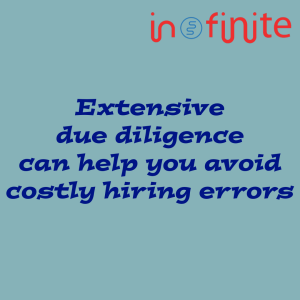The hiring process can be a tricky operation, moving from one interview to the next, comparing and contrasting candidates for important roles within your business. In some cases, this process can move at a snail’s pace, grinding out the interactions between company and candidate. In other cases, the process can move fast; we’ve all heard the stories of management jarringly extending a job offer at the end of the first interview.
It’s tempting to want to move slow or fast, depending on your team’s needs.
There’s a sweet spot in between those extremes, but it’s also tough to pin down. How fast or slow you should operate is a variable that’s dependent on what you’re hoping to achieve.
First, do you know how long it’s taken your team to fill your three most recently open executive-level positions? Take a look at past communications to get a sense of what happened. What can you learn from those experiences? And how can you recalibrate your goals for the next open position you’ll want to fill?
Here, we’ve laid out the pros and cons to moving too fast and moving too slow with your hiring decisions. Keep these tips in mind for your next trip through the hiring process.
Moving Too Fast With Your Hiring Process
 The Benefits:
The Benefits:
Attracting Top Talent Quickly: You scoop up the best execs before others even get a whiff of them. Speedy hiring allows you to snatch up the crème de la crème of executive talent, and when you move fast you can pounce on candidates who are in high demand. These A-list executives are often fielding multiple offers. Being the first to extend an offer can be a game-changer in securing their services.
Maintaining Momentum: No time to twiddle your thumbs; the market keeps moving and growing. A swift hiring process keeps the organizational wheels turning and allows for your team to respond to quickly changed market nuances. A speedy, deliberate process ensures that crucial leadership positions are filled promptly, preventing leadership voids that can bring important projects and initiatives to a grinding halt.
Knowing You Can Adapt: In fast-changing industries, you can pivot on a dime with quick hires. Some industries are like roller coasters, with rapid shifts in market conditions and opportunities (think tech or perhaps an industry adjacent to AI development). You might want to benefit from being able to inject fresh leadership and expertise where it’s needed to seize emerging prospects or navigate challenges. Agility is a competitive advantage.
The Downsides:
Working With a Limited Candidate Pool: You might miss out on hidden gems because you’re rushing, because moving too fast may end up limiting your candidate pool–when there may be a wider pool of available candidates, had you done a bit more legwork. When you move too fast, you might not have the time to thoroughly explore all potential candidates, potentially missing out on individuals who could be an even better fit for the executive role. This can result in a missed opportunity to find the most qualified and suitable candidate.
Taking on Increased Risk: There’s a real chance you’ll make a costly hiring blunder. Speedy hiring increases the risk of making a hiring mistake. When you’re under pressure to make a quick decision, there’s a higher likelihood of not conducting a comprehensive evaluation of candidates. What’s the rush? This tunnel vision can lead to choosing an executive who may not be the best long-term fit for the organization, resulting in costly turnover and potential disruption.
Missing That Crucial Cultural Fit: Speedy hires may not jibe with your company vibe, or at the very least this cultural mismatch becomes much more likely when you’re moving too fast.. Executives play a crucial role in shaping an organization’s culture and values. Failing to adequately evaluate how well a candidate aligns with the company culture can lead to disharmony and a lack of synergy among the leadership team and other employees.
READY TO GET STARTED? GET IN TOUCH WITH THE IN-FINITE TEAM TODAY
Moving Too Slow With Your Hiring Process
 The Benefits:
The Benefits:
Gathering a Comprehensive Evaluation: Slow and steady gives you the time for deep dives into candidates. Taking your time in the hiring process allows for a thorough and comprehensive evaluation of executive candidates. You can delve deep into their qualifications, skills, and experiences. This level of scrutiny can help ensure that the individual you select is an excellent fit for the role and the organization.
Reducing Your Risk: You play it safe with a thorough process, which is critical for top-level roles. A deliberate, slow hiring process reduces the risk of making a hiring mistake. It provides more time to check references, conduct multiple interviews, and assess a candidate’s track record in various contexts. This extensive due diligence can help you avoid costly hiring errors, which can be particularly critical for executive positions.
Developing a Team Consensus: More time for everyone to nod in agreement and avoid later squabbles. A slower pace permits more collaboration and consensus-building among stakeholders, such as board members, senior management, and key team members. This consensus helps to ensure that everyone is aligned in their expectations and support for the new executive. It reduces the chances of internal disagreements or resistance to the new hire.
The Downsides:
Losing Out on Top Talent: The best might not stick around while you’re twiddling your thumbs. The most highly qualified and sought-after executive candidates may lose interest or accept other job offers while you’re taking your time. Talented individuals tend to have multiple opportunities, and if your hiring process drags on, you risk losing them to more expedient competitors. (You don’t want that blunder to then push you too far in the opposite direction: moving too fast with your next preferred candidate!)
Stagnating: Slow hires mean slow decisions. A slow hiring process can lead to stagnation within the organization, and that can be infectious. The longer a crucial executive position remains vacant, the more it can impede decision-making and progress. Delays in filling leadership roles can result in missed business opportunities and hinder the overall momentum of the company.
Adding Up the Costs: Dragging it out takes a toll on your time and budget. Prolonged hiring processes consume time and resources. Not only does this delay the potential positive impact of the new executive, but it can also increase the overall cost of the hiring process, from HR staff time to external search firm fees. It’s an investment in time and money that can be better spent elsewhere.
When it comes to hiring top execs, it’s a bit of a Goldilocks situation: not too fast, not too slow, but just right for your company’s unique needs and pace.
So, how should your team calibrate that timeline?
Here are three questions to ask yourself as the hiring process gets under way:
How critical is this role? If you’re a startup, perhaps operating in the broader tech space, you might want to move a bit faster. This urgency might be compounded if you’re working in a highly competitive industry where top targets might be courted by similarly positioned companies. (Or maybe you’re hiring locally and drawing from a limited pool, geographically speaking.)
What are the current market conditions? Like anything else, the market will dictate how fast or slow you can allow yourself to move with your executive-level hiring decisions. Consider the stability of the candidate pool; a recruiting firm will have a great understanding of what this pool looks like for your industry. If the pool is relatively stable, you might find that you can take a more methodical approach. If demand outweighs supply in your market, it might be time to get moving–but get moving diligently.
What’s your internal decision-making process? Every company is built differently, but whether or not you’re working with a recruitment firm you will typically need more than one person to sign off on a new hire. Consider the various stakeholders involved in this decision, and let that guide the cadence of your interviews and potential job offers. Be deliberate in how you develop a timeline with a given candidate, knowing that Stakeholder A, B, or C may need to provide input on the decision along the way as well.
READY TO GET STARTED? GET IN TOUCH WITH THE IN-FINITE TEAM TODAY
INTERESTED IN THE IN-FINITE NEWSLETTER? SIGN UP BELOW >>>


 The Benefits:
The Benefits:  The Benefits:
The Benefits: